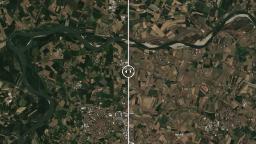[ad_1]

A painful lack of rain and relentless heat waves are drying up rivers in the US, Europe, Asia and the Middle East. Many are shrinking in length and breadth. Patches of riverbed poking out above the water are a common sight. Some rivers are so desiccated, they have become virtually impassable.
The human-caused climate crisis is fueling extreme weather across the globe, which isn’t just impacting rivers, but also the people who rely on them. Most people on the planet depend on rivers in some way, whether for drinking water, to irrigate food, for energy or to ship goods.
See how six of them look from space.
The Yangtze River
The Rhine River
The Rhine starts in the Swiss Alps, flows through Germany and the Netherlands and then flows all the way out to the North Sea. It’s a crucial channel for European shipping, but right now, it’s a nightmare to navigate.
Parts of the river’s bed have emerged above the water’s surface, meaning the ships that do try to pass it must weave around a series of obstacles, slowing the entire process.
The River Po
A big problem is that millions of people rely on the Po for their livelihood, mostly through agriculture. Around 30% of Italy’s food is produced along the Po, and some of the country’s most famous exports, like Parmesan cheese, is made here.
The Loire River
The Loire in France sustains a valley of vineyards that produce some of the world’s most famous wines. The river stretches over around 600 miles and is considered France’s last wild river, supporting biodiverse ecosystems throughout the valley, much of which is protected by The United Nations Educational, Scientific and Cultural Organization.
Parts of the river are fairly shallow already, but its levels and flow can change rapidly with the weather and as snow at its source melts. Some sections are so dried out from the lack of rain and extreme heat that people can cross by foot.
The Danube River
It’s not in as dire a condition as some of Europe’s other rivers, but countries like Hungary are so reliant on the Danube for tourism, the impacts are already being felt. Some cruise ships have been unable to pass parts of the river to even reach Hungary. Those that are still running can’t stop on their normal routes because so many stations have had to close as water levels on river banks fall. An average 1,600-ton vessel can now only navigate the Hungarian stretch without any cargo, according to the country’s tourist board.
CNN’s Julia Buckley, Laura He, Angela Fritz and Rachel Ramirez, as well as journalist Barbie Nadeau, contributed to this report.
[ad_2]
